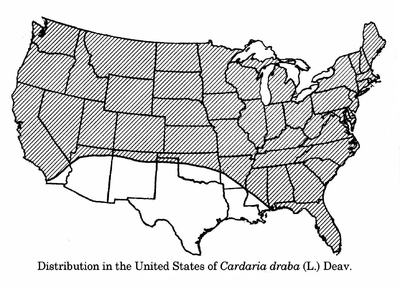
Whitetop
Encyclopedia
- Another plant, white star sedge, is also known as "whitetop".
Whitetop or hoary cress (Lepidium draba L. formerly Cardaria draba) is native to western Asia and eastern Europe and is an invasive species in North America, introduced by contaminated seeds in the early 1900s.
Whitetop is a perennial herb that reproduces by seeds and by horizontal creeping roots. The stem is stoutish, erect or spreading, 10 to 80 cm tall, branched, covered sparsely with ash-colored soft hairs to heavily covered. The leaves are alternating, simple, and mostly toothed. The basal leaves are 4 to 10 cm, have a slight stem (petiole), and are long and flat, lance-shaped to egg-shaped, with the narrow end attached to the stalk. On the upper part of the stem the leaves are attached directly to the stalk (sessile), are 2 to 6.5 cm long, and are oblong or tapering the point, with broad bases that clasp the stalk. Whitetop has slightly domed flower clusters in which the individual flower stalks grow upward from various points off the branch to approximately the same height (corymb-like). The petals are white, clawed, and 3 to 5 mm long, about twice the length of the sepal
Sepal
A sepal is a part of the flower of angiosperms . Collectively the sepals form the calyx, which is the outermost whorl of parts that form a flower. Usually green, sepals have the typical function of protecting the petals when the flower is in bud...
s.
Distribution in United States

External links
- Species Profile- Whitetop (Lepidium draba), National Invasive Species Information Center, United States National Agricultural LibraryUnited States National Agricultural LibraryThe United States National Agricultural Library is one of the world's largest agricultural research libraries, and serves as a National Library of the United States and as the library of the United States Department of Agriculture...
. Lists general information and resources for Whitetop.

